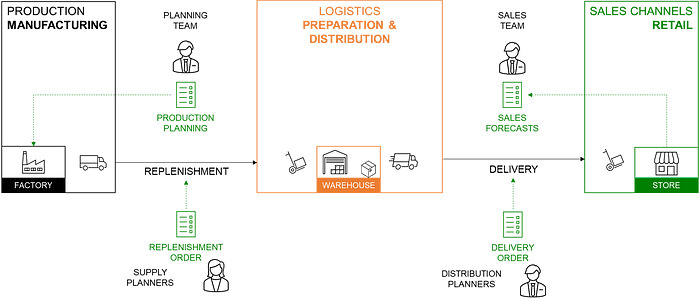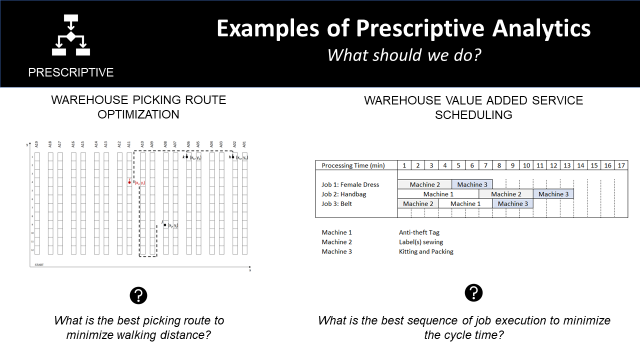What is Supply Chain Analytics?
Use data analytics with python to improve operational efficiency by enabling data-driven diagnostics and decisions at strategic and operational levels

Article originally published on medium.
A Supply Chain can be defined as several parties exchanging flows of material, information, or money resources to fulfil a customer request.

As information plays an important role, Supply chain Analytics has emerged as the methodologies and tools organizations use to get insights from data associated with all processes included in the value chain.
In this article, we will introduce the different types of Supply Chain Analytics with Python and understand their impact on the efficiency of your end-to-end operations.
💌 New articles straight in your inbox for free: Newsletter
I. Scenario
Example of a Supply Chain for a Fashion Retailer
II. What are the different types of Supply Chain Analytics?
1. Descriptive analytics2. Diagnostic analytics
3. Predictive analytics
4. Prescriptive analytics
III. Why is it so important?
IV. What skills do you need?
If you prefer watching, have a look at the YouTube tutorial
Scenario
Network
Let us take the example of an international clothing group that has stores all around the world.
The company produces garments, bags and accessories in factories located in Asia.

Stores are delivered from local warehouses and directly replenished by factories.

Flow of goods
- Warehouses are replenished with the bulk from the factories
- Stores' orders are picked, packed and shipped from local warehouses
Flows of information
- Sales and merchandising teams collect sales data from the stores
- Planning teams provide demand forecasts and support the production schedule
- Supply planners send orders to the factories for warehouse replenishment
- Distribution planners create store replenishment orders for the local warehouses
Let us now explore what kind of tools can be used to optimize the flow of goods using the information available.
As an introduction, you can have a look at this short explainer video
Different types of Supply Chain Analytics?
Supply Chain Analytics can be represented as a set of tools that will use the flow of information to answer questions and support the decision-making process.

For each type, you’ll need specific methodology, mathematical concepts and analytics tools to answer the question.
Descriptive Analytics
A set of tools to provide visibility and a single source of truth across the supply chain to track your shipments, detect incidents and measure the performance of your operations.

The final deliverable is usually a set of dashboards that can be put on the cloud using PowerBI/Tableau, such as a
- Warehouse Workload Report reporting the key indicators to measure a warehouse activity (orders prepared, productivity, logistic ratios)
- Supply Chain Control Tower to track your shipments along your distribution networks
- Transportation Route Analysis to visualize the routing of your past deliveries
Supply Chain Engineers, Data Analysts, Data Architects, Data Engineers, Product Managers and Business Intelligence Experts
🧰 TOOLS
Cloud computing, Python processing libraries (Pandas, Spark), BI Visualisation tools (Tableau, PowerBI, Google Studio)
Diagnostic Analytics
This can be summarized as incident root cause analysis. Let us take the example of the supply chain control tower.

Thanks to your data architecture, you can track your shipments at each step of the logistic chain.

For instance, in the chart above, you can see that long clearance lead times directly lead to late deliveries.
Supply Chain Engineers, Data Analysts, Data Engineers, Product Managers🧰 TOOLS
Cloud computing, Python processing libraries (Pandas, Spark), BI Visualisation tools (Tableau, PowerBI, Google Studio)
If a shipment is delivered late, the root cause analysis consists of checking each time stamp to see where your shipment missed a cut-off time.
The process of analysis is designed by the operational teams and implemented by data engineers for complete automation.
Predictive Analytics
Support the operations to understand the most likely outcome or future scenario and its business implications.

For example, by using predictive analytics, you can estimate the impact of future promotions on the sales volumes in stores to support inventory management.
Supply Chain Engineers, Data Scientists, Business Experts
🧰 TOOLS
Cloud computing, Python processing libraries (Pandas, Spark), BIMachine Learning, Statistics
In the example above, data scientists will work with business experts to understand which features can help improve the accuracy of sales forecasts.
Prescriptive Analytics
Assist the operations to solve problems and optimize the resources for efficiency.

Most of the time, prescriptive analytics are linked to optimization problems where you need to maximize (or minimize) objective functions considering several constraints.
Supply Chain Engineers, Data Scientists
🧰 TOOLS
Cloud computing, Python processing libraries (Pandas, Spark), BI
Machine Learning, Statistics, Linear Programming, Operations Research tools
Usually, the operational issue is linked to a well-known problem with solutions that can be found in the literature.
For instance, the travelling salesman or the job-shop problems are used in the abovementioned examples.
Why is it important?
As a supply chain manager, your scope of responsibilities includes
- Understand and minimize the risks
- Optimize operations to reduce costs
- Provide visibility for resource planning
- Prepare for future scenarios

Therefore, you need descriptive and diagnostic analytics to understand the current situation.
Predictive analytics will give you visibility into the future, while prescriptive analytics will support your decision-making.
What skills do you need?
Descriptive Analytics
This will depend on the type of analytics your position is involved in.
You will need basic programming skills to work with unstructured data using Python or VBA.
Often, data will be unstructured (in Excel files, pdf reports) or come from heterogeneous systems.

The first mandatory step is the processing and harmonization of information across these different sources and building descriptive capabilities.
Therefore, even if from a mathematical point of view it is the easiest part, descriptive analytics will take a large part of your energy (and budget).
Go beyond
After you’ve created a clean source of reliable data, you can start building models for diagnosis, prediction or prescription.
If you want to go into more detail, you can find examples of case studies in the articles listed below.
Descriptive Analytics
Diagnostic Analytics
- Logistic Performance Management Using Data Analytics
- Lead Times Variability and Supply Chain Resilience
Predictive Analytics
Prescriptive Analytics
- Production Fixed Horizon Planning with Python
- Optimize Warehouse Value Added Services with Python
- Improve Warehouse Productivity using Pathfinding Algorithm with Python
- Machine Learning for Store Delivery Scheduling
About Me
Let’s connect on Linkedin and Twitter, I am a Supply Chain Engineer that is using data analytics to improve logistics operations and reduce costs.
If you’re looking for tailored consulting solutions to optimize your supply chain and meet sustainability goals, feel free to contact me.



